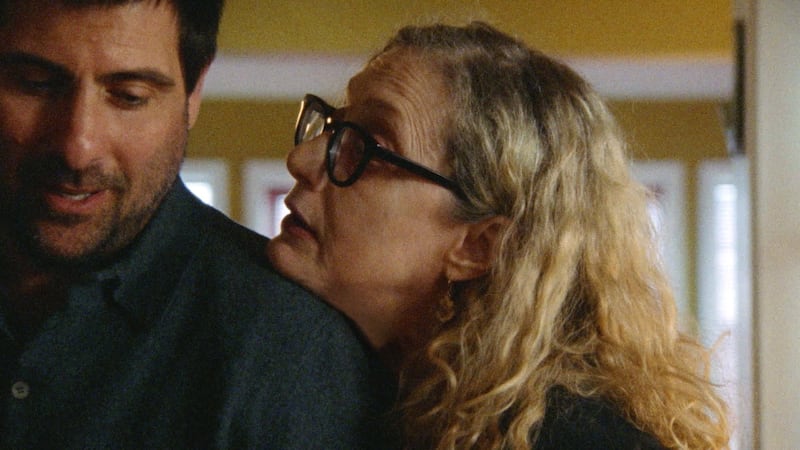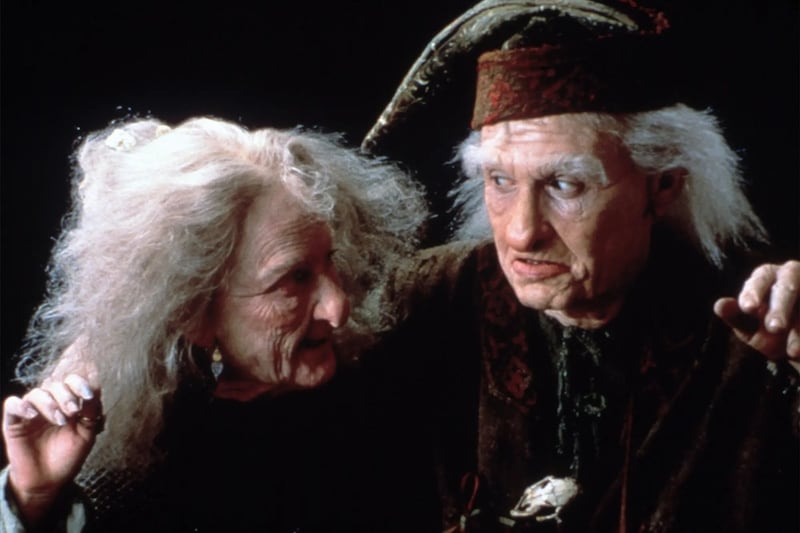Between the Temples is a pleasing New York-set comedy featuring Jason Schwartzman as Ben, a widowed cantor who finds solace and amusement in Carla, an older woman, played by Carol Kane, who hopes to make her bat mitzvah now that her disapproving communist parents are dead.
Friends and family don’t know how to respond to this odd bond between a man and his childhood music teacher. Nor, indeed, does the viewer. Whether it’s awkward synagogue singing, revelatory cassette recordings of Ben’s late wife, or madcap dinner parties, this much-admired Sundance wow from the writer and director Nathan Silver is the most unpredictable comedy of the year.
“It was just as unpredictable for us,” Kane says, laughing. “That’s a factual description, because the scenes were written the night before, or two nights before. There was no script handed out before we started to shoot. We would do the scenes as written, and then Nathan would watch what we did and say, ‘Oh, no, no, no.’ That’s about it.
“We kept working on it, chiselling away, improvising, all together with Nathan and our incredible director of photography, Sean Price Williams – who I consider a character in the film, since we frequently didn’t know what was going to happen in the scene until we shot it, which meant he had to be right in there, like a character.”
READ MORE
Kane came to prominence in the 1970s with her Oscar-nominated turn in Hester Street. Aged 23, she worked with a Yiddish language coach to play a 19th-century Jewish immigrant struggling with an unfaithful husband and assimilation on the Lower East Side. Learning a bat-mitzvah script for Between the Temples was, she says, far more daunting.
“I didn’t know until I saw the finished film that it is dedicated to Joan Micklin Silver,” Kane says, referring to the director of Hester Street. “That was wonderful. But learning Hebrew was terrifying. I didn’t speak Yiddish, but I worked with this wonderful actor, and Yiddish is more familiar to my ear musically. Hebrew is a different animal altogether. I had a very patient teacher and support from Nathan and Jason.
“I could not guarantee that I would do a good job. It’s not just the words: it’s the chanting; it’s the rhythm. That was all new for me. Even though my mother’s a brilliant musician. I had to take a leap of faith and hope I would be adequate on the day.”
Carolyn Laurie Kane was born in Cleveland, Ohio. Her mother was a jazz singer, composer and dancer; her father was an architect whose job brought the family to France and later Haiti, but her perambulatory childhood ended with her parent’s divorce, when she was 12.
“I think our family was in some distress when I was young,” Kane says. “And then my mother took me to see this children’s theatre play. That’s when I saw these people, these other children, up there on stage, blossoming, using their imagination and getting to be someone other than who they really were. I loved their spirits and their hearts. I thought, oh, there it is: that’s what I want to be part of.”

The rapturous reception for Between the Temples is a delightful turn of events for Silver, a prolific indie film-maker – he has directed 12 features since 2009. The film is arguably a career best for Schwartzman, who finds new directions for the widowed grief he brought to last year’s Asteroid City.
Kane favourably compares her costar to her early scene partners Al Pacino and Jack Nicholson. Her early career is an extraordinary run of films and directors, including Mike Nichols’s Carnal Knowledge, Hal Ashby’s The Last Detail, Sidney Lumet’s Dog Day Afternoon, Ken Russell’s Valentino, Woody Allen’s Annie Hall and Elaine May’s Ishtar.
“I would say that lucky is an understatement,” she says. “I started so young with great writing. I was spoiled. I started with The Prime of Miss Jean Brodie on stage. Great writing is everything to me. And I worked with some of the greatest writers, including Robert Towne, who just passed away, and Woody Allen and Jim Brooks and John Cassavetes.
“I was so blessed to work with these great writers and actors. And here I feel like it’s happening again, because I got to work with Jason Schwartzman.”
Despite her early hit rate with movies, it was the TV show Taxi that made Kane a household name in the United States. She won two Emmys for playing Simka, the wife of Andy Kaufman’s immigrant mechanic, Latka Gravas, who spoke an invented language. She and some of the other cast members, including Marilu Henner, Judd Hirsch, and Christopher Lloyd, reprised their roles in Man on the Moon, Milos Forman’s 1999 biopic of Kaufman.
“Taxi was very much scripted,” Kane says. “We had genius writers, Jim Brooks and Ed Weinberger. We would stick to the script, except that I didn’t get to rehearse with Andy very much, because he had it in his contract that he would just basically rehearse 1½ days a week out of the five days that we rehearsed.
“So it was pretty new when we shot it. Because that was his background in stand-up comedy. Although really he was more of a performance artist than a stand-up. We were working in front of a live studio audience. TV doesn’t work like that any more. I don’t know why. It’s the best format. It’s like theatre.”
Since the 1990s Kane has worked with Jacques Audiard, Jim Jarmusch, Gus Van Sant and Nisha Ganatra. She helped shape the character of Madame Morrible during the earliest tours of Wicked: The Musical. Her experiences with new Hollywood are mirrored by her recent much-praised TV work on Star Trek: Strange New Worlds and Unbreakable Kimmy Schmidt. It’s all about the people around you, she says.
“With movies and theatre and TV, they’re so collaborative. You’re not on your own. You have to open up and let other people in. And that’s kind of scary, because most of us in artistic fields are kind of control freaks. But what’s interesting is that we’re in this collaborative art, and you can’t control it. You have to give yourself over. If you try to control it you diminish the experience.”
On this side of the Atlantic she is typically recognised for her roles in three family classics: as Grandmama in Addams Family Values, as the violent Ghost of Christmas Present who repeatedly clobbers Bill Murray in Scrooged, and under much witchy latex opposite Billy Crystal in The Princess Bride.

“I do know that making The Princess Bride, there was something a little bit otherworldly about that experience,” Kane says. “Everyone was so great. I mean, Bill Murray is my idol. And it’s so great to be part of Scrooged and a Christmas tradition. But with The Princess Bride, all those genius actors were in one room together. It was a breathtaking experience. The speed of the jokes and the work was incredible.
“You’ve probably heard this story, but during that scene when Billy was improvising about a nice lean mutton sandwich, Mandy Patinkin actually broke a rib trying not to laugh. My make-up took so long that I didn’t get on the set for about four hours after everybody else did. By the time I used to get down there, there was some kind of rarefied atmosphere.
[ The Movie Quiz: Which Irish landmark appears in The Princess Bride?Opens in new window ]
“The cool thing is that Rob Reiner” – the film’s director – “has this thing where he’s so tickled by the work that he laughs out loud, right next to the camera. It’s problematic for the editor. But it’s great for the actors.”
Between the Temples opens in cinemas on Friday, August 23rd



















